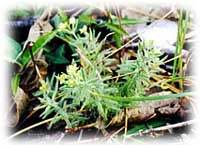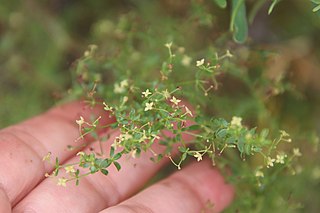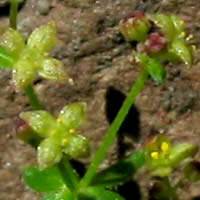
Plant reproductive morphology is the study of the physical form and structure of those parts of plants directly or indirectly concerned with sexual reproduction.

Galium boreale or northern bedstraw is a perennial plant species of the Rubiaceae family. It is widespread over the temperate and subarctic regions of Europe, Asia and North America including most of Canada and the northern United States.

Galium angustifolium is a species of flowering plant in the coffee family known by the common name narrowleaf bedstraw. It is native to California and Baja California, where it is most commonly found at low elevations in the mountains.
Galium bolanderi is a species of flowering plant in the coffee family known by the common name Bolander's bedstraw. It is native to the mountains of California and southern Oregon. It is a resident of mountain forests and chaparral slopes.

Galium buxifolium is a rare species of flowering plant in the coffee family known by the common names box bedstraw and island bedstraw. It is endemic to the Channel Islands of California, where it is known from about 26 populations on two of the islands. It is a federally listed endangered species of the United States.

Galium californicum is a species of flowering plant in the coffee family known by the common name California bedstraw.

Galium divaricatum is a species of flowering plant in the coffee family known by the common name Lamarck's bedstraw.
Galium matthewsii is a species of flowering plant in the coffee family known by the common names bushy bedstraw and Matthews' bedstraw. It is native to the mountains and deserts of southeastern California, and southern Nevada.

Galium porrigens is a species of flowering plant in the coffee family known by the common names graceful bedstraw and climbing bedstraw. It is native to the west coast of North America from Oregon to Baja California.

Clematis hirsutissima is a species of flowering plant in the buttercup family known by the common name hairy clematis or vase flower. It is a perennial herb that is native to much of the western United States, from Washington to Nebraska. It is a small, erect plant which, unlike other Clematis, does not generally produce vines. It is quite variable in appearance, especially across varieties. In general the hairy stem reaches up to about half a meter tall and has many large hairy leaves divided into lance-shaped lobes. The inflorescence appears at the tip of the stem and bears a solitary flower. The flower is made up of an urn-shaped cup of deep purple-blue petal like sepals, which are fuzzy and have pointed or rounded tips. Rare individuals have white or pinkish sepals. There are no true petals. The fruit is a hairy achene with a very long beak and a plume on the end; it is dispersed by wind.

Galium nuttallii is a species of flowering plant in the coffee family known by the common names San Diego bedstraw and climbing bedstraw. It is native to the coast and coastal Peninsular and western Transverse Ranges of southern California and Baja California, where it is a member of chaparral and pine woodland plant communities. It is also found on the Channel Islands and on the mainland as far north as Santa Barbara County

Symphyotrichum defoliatum is a species of flowering plant in the family Asteraceae known by the common name San Bernardino aster. It is endemic to Southern California where it grows in grasslands and meadows, and it is of conservation concern.

Symphyotrichum greatae is a species of flowering plant in the family Asteraceae endemic to California and known by the common name Greata's aster.

Yolla Bolly bedstraw is a species of plant in the family Rubiaceae, native to British Columbia, northern California and southeastern Oregon.

Galium catalinense is a species of flowering plant in the coffee family known by the common name Santa Catalina Island bedstraw. It is endemic to two of the Channel Islands of California, where it grows along the coastal bluffs. It is a shrub growing erect to about a meter in maximum height with a rigid stem lined with whorls of four leaves each. The hairy leaves are generally lance-shaped and one to 2.5 centimeters long. The inflorescence emerging from leaf axils is a dense cluster of whitish flowers.
Galium glabrescens is a species of flowering plant in the coffee family known by the common name Castle Lake bedstraw. It is native to the mountains of far northern California and southern Oregon, including the Klamath Mountains.

Galium parisiense is a species of flowering plant in the family Rubiaceae known by the common name wall bedstraw. A native of the Mediterranean area and Western Europe, it has become naturalised in North America and other parts of Europe.
Linanthus concinnus is a species of flowering plant in the phlox family known by the common name San Gabriel linanthus. It is endemic to the San Gabriel Mountains in the Los Angeles area, where it occurs in dry, rocky habitat in chaparral and forest habitat. This is a small annual herb producing a thin, hairy, glandular stem no more than about 12 centimeters tall. The leaves are divided into narrow, threadlike linear lobes up to 1.5 centimeters long. The inflorescence is a cluster of 3 to 7 funnel-shaped flowers. The lobes of the corolla are up to a centimeter long and white with 2 magenta marks at the base of each.
Diplacus johnstonii is a species of monkeyflower known by the common name Johnston's monkeyflower.

Cardiospermum halicacabum, known as the lesser balloon vine, balloon plant or love in a puff, is a climbing plant widely distributed across tropical and subtropical areas of Africa, Australia, and North America that is often found as a weed along roads and rivers.















